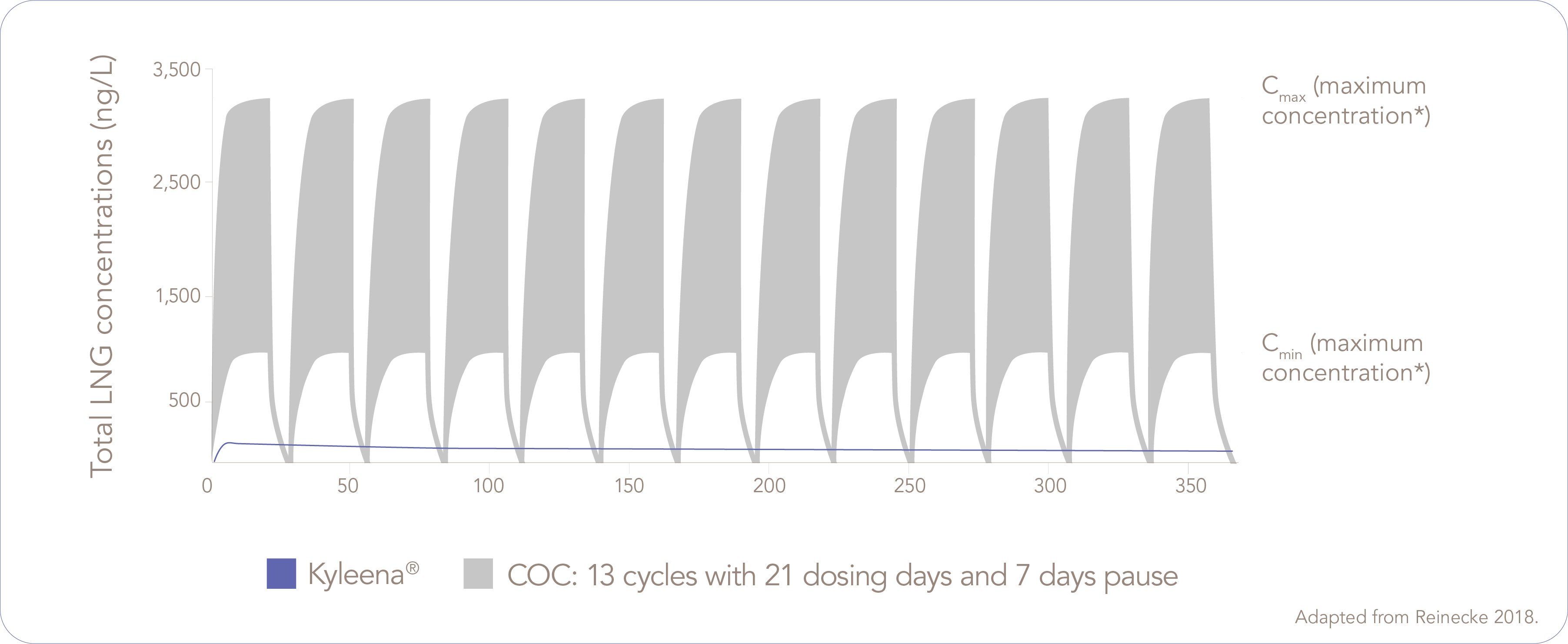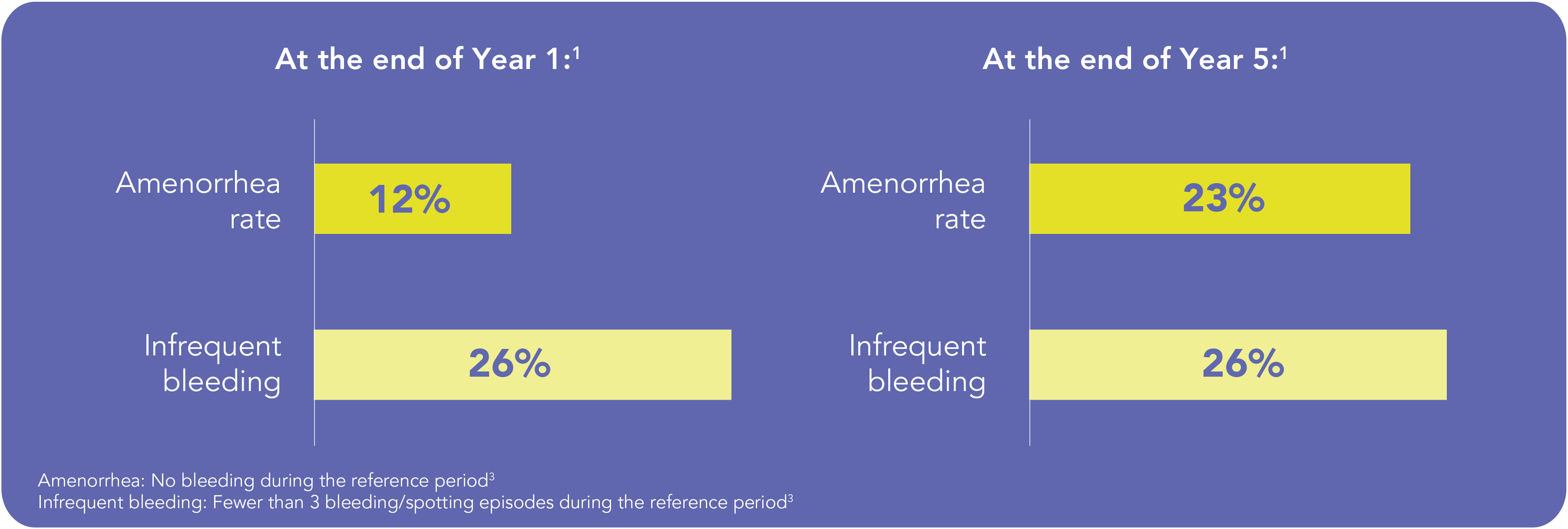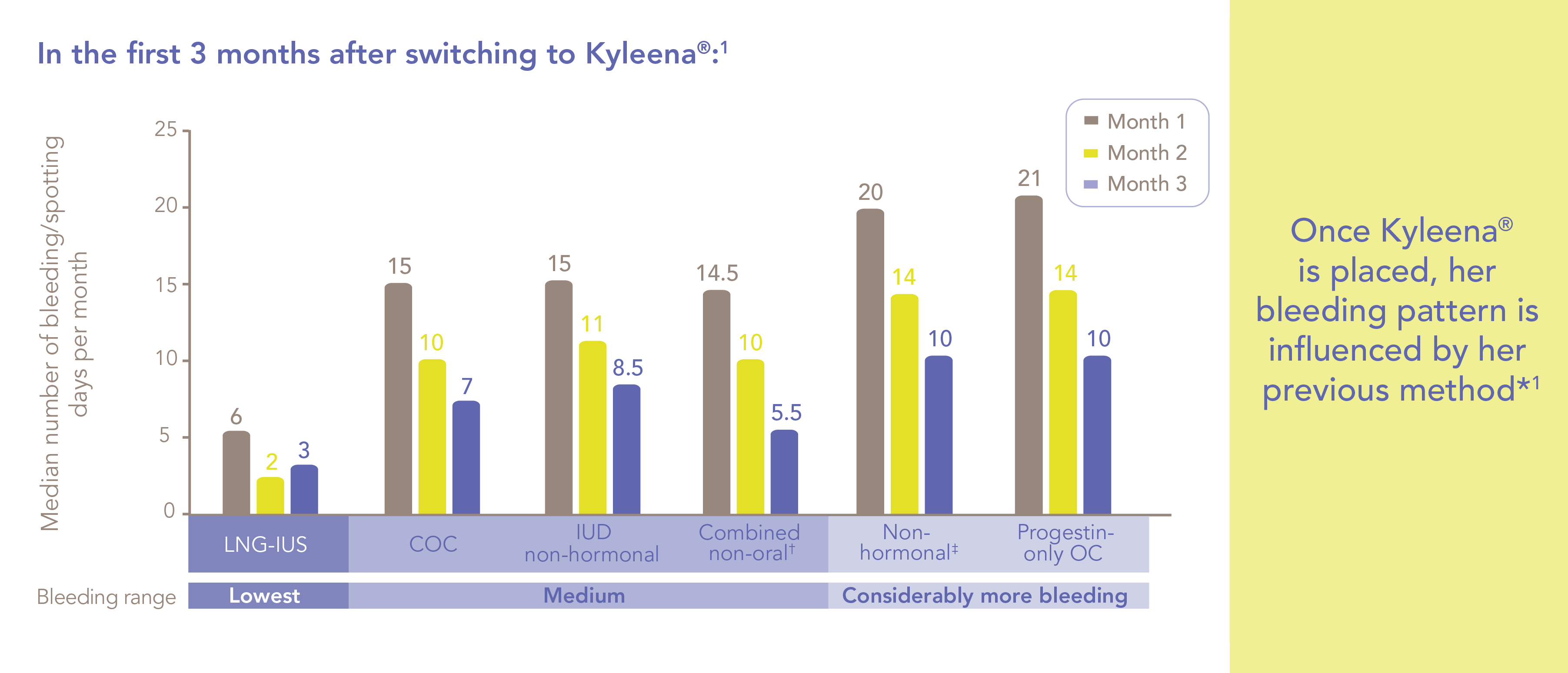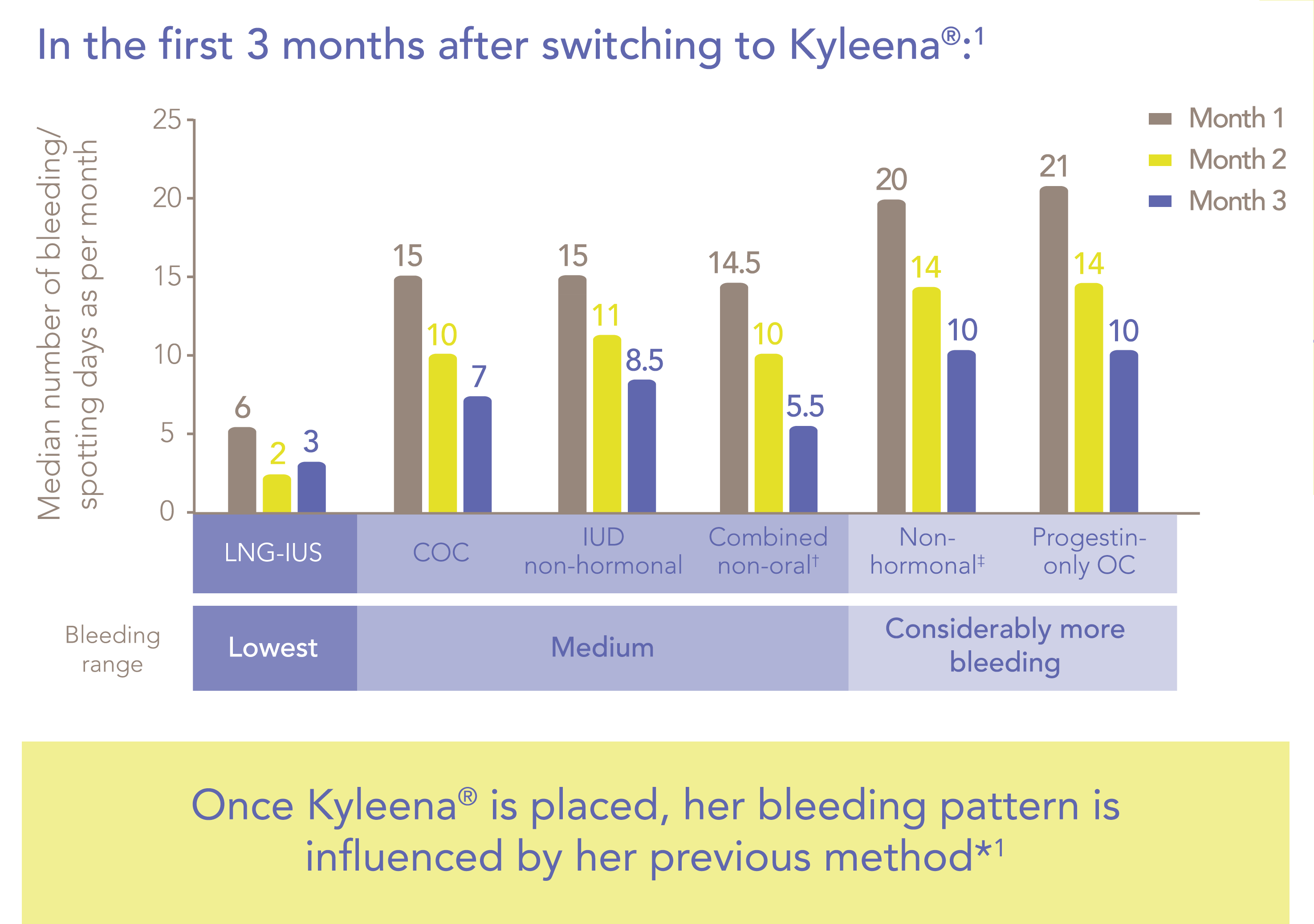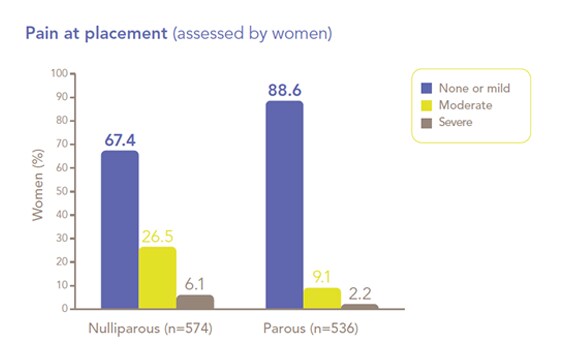FE | Risk Minimisation Patient
Title
Kyleena®: a low-dose, highly effective IUS with up to 5 years of contraception1
Independent of age and parity, Kyleena® provides reliable contraception with a 5-year Pearl Index of 0.291,2
Kyleena® offers a low and consistent level of LNG compared with standard COCs3
- The failure rate was approximately 0.2% at 1 year and the cumulative failure rate was approximately 1.4% at 5 years.11 Return to content
BC – birth control; COC – combined oral contraceptive; IUS – intrauterine system; LNG – levonorgestrel
- Kyleena® Summary of Product Characteristics. Return to content
- Gemzell-Danielsson K, Apter D, Dermout S et al. Eur J Obstet Gynecol Reprod Biol 2017;210:22–28. Return to content
- Reinecke I, Hofmann B, Mesic E et al. J Clin Pharmacol 2018;58(12):1639–1654. Return to content
- Nelson AL. Expert Rev Clin Pharmacol 2017;10(8):833–842. Return to content
Title
Kyleena® has a different mechanism of action compared to the pill
Kyleena® is inserted into the uterine cavity, where it releases low levels of LNG for up to 5 years1
As a result, systemic exposure to LNG is low when compared to other LNG-containing contraceptives1,2
With Kyleena®, the natural hormone production of women is unaffected and ovarian function remains normal1
- Kyleena® Summary of Product Characteristics. Return to content
- Bayer. Microlut. Product Information (2017). Available at: http://www.bayerresources.com.au/resources/uploads/PI/file9397.pdf [Accessed November 2020]. Return to content
- Alvergne A and Lummaa V. Trends Ecol Evol 2010;25(3):171–179. Return to content
- Apter D, Gemzell-Danielsson K, Hauck B et al. Fertil Steril 2014;101(6):1656–1662. Return to content
Title
Kyleena® is associated with lighter, shorter and less frequent bleeding over time.1
After the adaptation phase, women are likely to have a gradual reduction in the amount and number of days of bleeding each month.1
Some women eventually find that bleeding stops altogether,2 with 23% experiencing amenorrhea at the end of Year 5.1
For women who want a low-dose contraceptive with shorter, lighter bleeding, consider Kyleena®1
- In most cases, the adaptation phase lasts for 3 months. Return to content
- Kyleena® Summary of Product Characteristics. Return to content
- Nelson A, Apter D, Hauck B et al. Obstet Gynecol 2013;122(6):1205–1213. Return to content
- Belsey EM, Machin D and d’Arcangues C. Contraception 1986;34(3):253–260. Return to content
Title
Counselling women is essential during the first few months after Kyleena® placement
Initial increases in bleeding as the endometrium adjusts to Kyleena® decline after Month 1.1,2
Recommend MyIUS at the time of Kyleena® prescription to help women track their bleeding profile
* Phase III data were analyzed according to previous contraceptive use (N=1,452).1
† For example: birth control patch or birth control ring.
‡ Other than cooper-IUDs, for example barrier methods and fertility awareness-based methods.
IUD – intrauterine device; IUS – intrauterine system; LNG – levonorgestrel; OC – oral contraceptive
- Beckert V, Ahlers C, Frenz A-K, et al. Eur J Contracept Reprod Health Care 2019;24(4):251–259. Return to content
- Kyleena® Summary of Product Characteristics. Return to content
Title

IUS – intrauterine system; LNG-IUS – levonorgestrel-release intrauterine system
- Nelson A et al. Obstet Gynecol 2013;122:1205–1213. Return to content
- Kyleena® Summary of Product Characteristics. Return to content
- Beckert V, Aqua K, Bechtel C et al. Eur J Contracept Reprod Health Care 2020;25(3)182–189. Return to content
Title
Kyleena® is suitable for women who want a fast return to normal fertility after stopping contraception1
Kyleena® does not impact future fertility – women return to their normal fertility upon removal.1
68% of women think that a fast return to their usual fertility after stopping contraception is important.2
- Kyleena® Summary of Product Characteristics. Return to content
- Merki-Feld GS, Caetano C, Porz TC et al. Eur J Contracept Reprod Health Care. 2018;23(3):183–193 Return to content
Title
Kyleena® is associated with high rates of user satisfaction1
In a Phase III study enrolling nulliparous and parous women (18–35 years old):1
- 99.1% of women reported that they were ‘very satisfied’ or ‘somewhat satisfied’ with Kyleena® after 5 years of use1
- 85.1% of women stated that they would continue with Kyleena® after study completion, if given the choice1

LNG-IUS – levonorgestrel-release intrauterine system
- Gemzell-Danielsson K, Apter D, Dermout S et al. Eur J Obstet Gynecol Reprod Biol 2017;2010:22–28. Return to content
- Beckert V, Aqua K, Bechtel C et al. Eur J Contracept Reprod Health Care 2020;25(3)182–189. Return to content
Title
Choose the IUS that best meets her needs
| Jaydess®1 13.5 mg intrauterine delivery system (levonorgestrel) |
Kyleena®2 19.5 mg intrauterine delivery system (levonorgestrel) |
Mirena®3 52 mg intrauterine delivery system (levonorgestrel) |
|
|---|---|---|---|
| Indication | Contraception for up to 3 years | Contraception for up to 5 years | Contraception for up to 5 years Treatement of HMB for up to 5 years endometrial protection during HRT for 4 years |
| Pearl Index (efficacy) | Year 1:0.41 3-years: 0:33 |
Year 1: 0.16 5-years: 0.29 |
Year 1: 0.2 Years 5: 0.144 |
| Contraceptive failure rate | 0.4% at 1 year 0.9% over 3 years |
0.2% at 1 year 1.4% over 5 years |
0.2% at 1 year 0.7% over 5 years |
| Total levonorgestrel (LNG) content (mg) | 13.5 | 19.5 | 52 |
| Average in vivo LNG release rate over the first year of use | 8 μg/24 hours | 12.6 μg/24 hours2 | 20 μg/24 hours |
| % of women experiencing amenorrhoea and infrequent bleeding at 1 year post insertion | Amenorrhoea: 6% infrequent bleeding: 20% |
Amenorrhoea: 12% infrequent bleeding: 26% |
Amenorrhoea: 16% infrequent bleeding: 57% |
| T-frame size (mm) | 28 × 30 | 28 × 30 | 32 × 324 |
| Placement tube diameter size (mm) | 3.8 | 3.8 | 4.4 |
| Colour of monofilament threads | Brown | Blue | Brown |
| Differentiator in imaging techniques:silver ring | Improved visibility on ultrasound | Improved visibility on ultrasound | - |
HMB – heavy menstrual bleeding; HRT – hormone therapy
- Jaydess® Summary of Product Characteristics. Return to content
- Kyleena® Summary of Product Characteristics. Return to content
- Mirena® Summary of Product Characteristics. Return to content
- Mirena® Product Information (Bayer Australia). Return to content
Kyleena®: Frequently asked questions
Below you will find answers to some commonly asked questions about Kyleena®. These will support you when discussing Kyleena® with women seeking contraception in your clinical practice.
Kyleena® should be inserted before the end of the month stated on the carton and the blister after ‘EXP:’. The sterile package in which Kyleena® is supplied must not be opened until required for placement. Kyleena® should not be used if the seal of the sterile package is broken or appears compromised. Strict aseptic techniques should be used throughout the placement procedure. Kyleena® is for single use only and should not be resterilised.1
- Kyleena® Summary of Product Characteristics. Return to content
Kyleena® (19.5 mg intrauterine delivery system levonorgestrel) is an intrauterine system indicated as a contraceptive for the prevention of pregnancy for up to 5 years.1
Kyleena® offers more than 99% contraceptive efficacy for each year of use and supports women who fear an unintended pregnancy by providing reliable contraception, regardless of age and parity.1,2
In a multicentre study, a survey showed that 48% of women aged 18–44 and, in particular, 57% of young women aged 18–24 forgot to take their contraceptive pill in the last 3 months.3 Kyleena® can be beneficial for women who struggle to comply with daily pill regimens, offering long-term contraception that suits their needs.1,3
In the same survey, 87% of women mentioned that a method not requiring daily, weekly or monthly dosing would make things easier and 80% would consider switching contraceptives to minimize estrogen exposure.3 Kyleena® is estrogen-free and offers the lowest hormone exposure compared with any non-IUS hormonal BC method such as pills, rings or implants.1,4,5
BC – birth control; IUS – intrauterine system
- Kyleena® Summary of Product Characteristics. Return to content
- Gemzell-Danielsson K, Apter D, Dermout S et al. Eur J Obstet Gynecol Reprod Biol 2017;210:22–28. Return to content
- Hooper DJ. Clin Drug Investig 2010;30(11):749–763. Return to content
- Reinecke I, Hofmann B, Mesic E et al. J Clin Pharmacol 2018;58(12):1639–1654. Return to content
- Nelson AL. Expert Rev Clin Pharmacol 2017;10(8):833–842. Return to content
Kyleena® should be inserted into the uterine cavity during the first seven days of the menstrual cycle or immediately after a first-trimester abortion. Backup contraception is not needed when Kyleena® is inserted as directed.1
- Kyleena® Summary of Product Characteristics. Return to content
The removal threads of Kyleena® are contained within the placement tube and handle. While this design allows you to load Kyleena® without handling the threads manually, it also means Kyleena® can only be loaded once.1
By pushing the slider on the inserter forward, Kyleena® loads into its proper position in the placement tube. Do not move the slider downward at this time, as this may prematurely release the threads of Kyleena®. Once the slider is moved below the mark, Kyleena® cannot be reloaded.1
- Kyleena® Summary of Product Characteristics. Return to content
No. The clinical development program for Kyleena® did not include trials designed to obtain that indication.1
- Kyleena® Summary of Product Characteristics. Return to content
In general, there appears to be no deleterious effect on infant growth or development when using any progestogen-only method after 6 weeks postpartum. A levonorgestrel-releasing intrauterine system does not affect the quantity or quality of breast milk. Small amounts of progestogen (about 0.1% of the levonorgestrel dose) pass into the breast milk in nursing mothers.1
- Kyleena® Summary of Product Characteristics. Return to content
If a woman wishes to continue using Kyleena®, a new system can be inserted to replace the old one. Removal of the original system should be carried out within 7 days of the onset of menstruation. In this case, no additional protection is required, assuming the woman is experiencing regular menses.1
- Kyleena® Summary of Product Characteristics. Return to content
Kyleena® has not been associated with weight gain.1
In one recent study that evaluated the use of Kyleena® over 5 years, the investigators recorded a mean cumulative increase in body weight from baseline of 1.1 kg at Month 36 and 2.2 kg at Month 60/end of 5-year study. The authors noted that this increase was similar to that observed in women using the copper intrauterine device (2.5 kg over 5 years) and the background increase observed in a nationwide study of American women with a mean age of 29.2 years, which recorded an increase of 0.52 kg per year.1
- Gemzell-Danielsson K, Apter D, Dermout S et al. Eur J Obstet Gynecol Reprod Biol 2017;2010:22–28. Return to content
The use of a levonorgestrel-releasing intrauterine delivery system does not alter the course of future fertility. Upon removal of the intrauterine system, women return to their normal fertility.1
- Kyleena® Summary of Product Characteristics. Return to content




